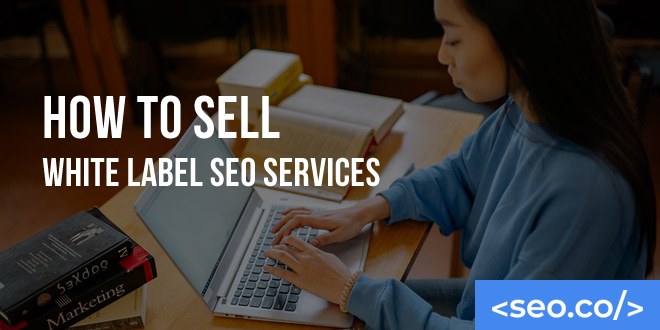With the size of the market, there is plenty of competition, but you can still sell SEO, but doing so means you need to prove your value to clients.
As an SEO link building agency, you spend a lot of time thinking about customer acquisition and customer retention. You’ve got designers, writers, strategists, and account managers—some of the best in the business—but you’ve got to keep them busy with a steady flow of client work if you want the organization to survive.
While customer acquisition and new business are important, customer retention is even more important, and if you’re on retainer with the majority of your clients, it’s plain to see why. Customers who stick with you become a reliable source of recurring revenue—and with enough of them, you don’t have to worry about chasing down new leads.
There’s only one reliable way to increase customer retention in a digital marketing agency, and that’s by proving your value.
Marketing services aren’t often seen as “necessary” the way office space or workforces are, and even if they were, there are hundreds to thousands of competing firms ready to swoop in and take your clients away from you. The trouble is, with so many digital marketing strategies with hard-to-prove metrics and increasingly skeptical audiences, it’s more difficult than ever to prove you’re worth every dollar a client spends with you.
Fortunately, there are ways around these pitfalls. As a marketing agency that provides link building support like us, you need to deliver results worth more than the cash your clients are giving you if you want them to stick around. This is how you do it.
Table of Contents
General Advice
First things first. There are a handful of general rules you’ll need to follow if you want to be perceived as a “valuable” agency. Remember, perceived value isn’t always the same as tangible value—and tangible value is worthless if it isn’t effectively demonstrated. How and when you interact with your client can make all the difference in whether your “value proof” is effective.
Here’s how you can do it:
- Communicate! I use an exclamation point here and put this entry first because it’s easily the most important factor on this list (and maybe the best piece of advice in the whole guide). If you want to show your value to your client, you have to communicate, all the time. Talk about what you’re doing, how you’re doing it, how it went, what happened after, why it happened, and what you’re going to do next. If your client requests less communication (unlikely), that’s fine, but strive to be as complete and coherent as you can from the beginning. This includes sending over reports regularly, following up whenever things go wrong, and generally being as transparent as possible.
- Be proactive. We all make mistakes. Just because you’re an expert doesn’t mean you’re exempt from this. Inevitably, one of your strategies is going to backfire, and your client is going to lose traction. Consider how Rap Genius’s relatively innocent idea was interpreted as a link scheme by Google (which ended up getting them severely penalized):
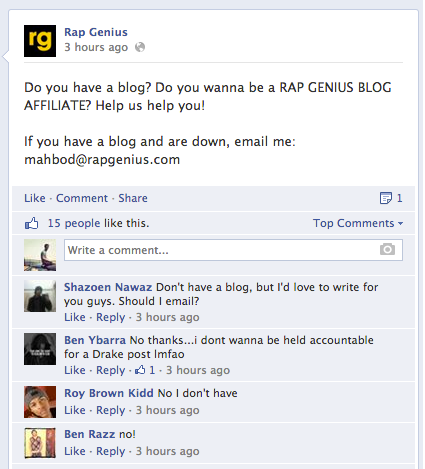
(Image Source: Rap Genius)
- Like it or not, this can happen to you and your client. Unfortunately, one bad mistake can take precedence over all the good you’ve done, and the shock of the initial reveal can compound this effect. However, if you’re proactive—letting your customer know what’s going on early and often—you can reduce the effects of such a blowup.
- Be consistent. Consistency is a demonstration of reliability, and it can become an inherent value in itself. For example, if you have weekly email updates and monthly reports, keep those exchanges as consistent as possible. Send them at the same time, in the same format, with the same type of recaps to go along with them. This creates a consistent rhythm on the client side that becomes harder to break—inherently making you a more secure, valuable resource to the team.
- Know your clients. Different clients are going to have different demands, different ideals, and different dispositions. You need to be intimately familiar with these if you want to effectively prove your value to each one. For example, you may have a small business owner who knows nothing about online marketing and is nervous about “new” marketing techniques like social media engagement or SEO. For these clients, you’ll need to spend extra time communicating and explaining the gist of your strategic initiatives. On the other hand, you might have a seasoned serial entrepreneur running an eCommerce platform who only cares about bottom-line results. Here, the better way to demonstrate value is by showing the greatest signs of numerically provable growth.
- Once you learn what’s most effective and what your clients most want, you can start prioritizing your work. For example, if you’re seeing the best results from your content marketing campaign, you can convince your client to allow you to increase efforts there (at the possible expense of a less profitable department). This will help you maximize the results you have to show at the end of your campaign.
- Cross-communication. Don’t blame me for using another variant of “communicate”—this should be a distinct goal. For most of your clients, you won’t always be communicating with the decision maker. For example, you might give weekly updates to a designated marketing contact, who then relays that information to a CEO, who may ultimately decide to pull the plug on your relationship. If this information is mishandled or isn’t relayed effectively, your entire relationship could be compromised. Do what you can to get everyone in the room for your most significant updates, and keep everyone on the same page.
- Celebrate the wins. Just like every agency is bound to make mistakes, every agency is bound to have some awesome wins. Take a look at how often long-form content posts are shared on social media:
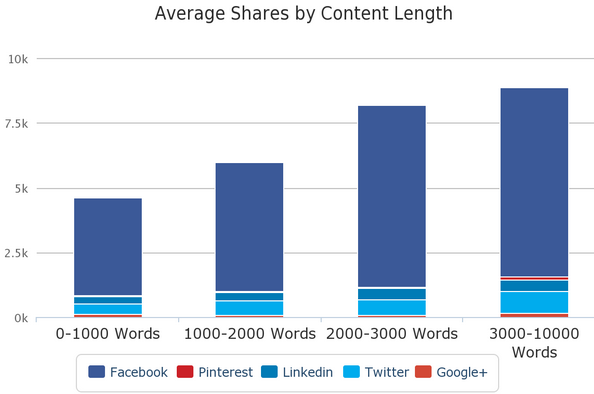
(Image Source: BuzzSumo)
- Your client may not be initially convinced that such a major investment in SEO content is worth the cost—but if you’re able to successfully get 10,000 likes out of such a piece, you’ll have cause to celebrate. Don’t let these wins pass you by—call up your client immediately with the good news, and consider an even bigger gesture for the bigger wins, like celebrating over drinks or dinner. This will help cement these “anchor points” of value in your clients’ minds.
- Establish a timeline. You’re going to have ups and downs throughout the entirety of your client relationship, no matter what. You’re at your most vulnerable when you hit a slump, or a period of stagnation. It’s in these times that your client will start to question your overall value. To mitigate this effect, strive to establish a longer timeline, identifying how you’ve improved since the beginning of the relationship rather than the past month. For example, if you’ve lost 300 organic visitors per month since the beginning of the year, you can remind your client that this “low” figure is still 1,000 visitors higher than where they started just a few years ago.
With that introductory advice out of the way, let’s move on to more tangible ways to prove your value.
Hard Facts: Proving ROI
As a marketing agency, you have to love numbers. Numbers are objective; they don’t require finagling, manipulation, or candy-coating to sell your service. If you can objectively prove the value of your work, you’ll never have to worry about a client leaving.
The question is, how can you prove that value?
For most modern marketing agencies, it comes down to a basic calculation of ROI (return on investment). To keep things simple, I’m going to assume that the majority of your marketing campaigns can be measured for success based on conversions and/or traffic, but you can substitute other metrics here as well—it’s really a matter of semantics.
Know the Costs
First, you need to know how much you’re actually costing your client. You may or may not know this, depending on how closely your sales and strategy departments work together. For agencies on retainer, this rate is simple—it boils down to a consistent, unchanging monthly fee that you can use in all your future calculations.
If your rate is variable, or if your client only pays for select services on an irregular basis, you’ll have a harder time making an accurate equation. Do your best to calculate an average monthly expenditure (or look at only one month at a time), and set that figure aside; we’ll be revisiting it shortly.
Conversions
Conversions can take many forms; for these purposes, I’ll define a conversion as an instance of a user taking meaningful action, which can then be translated to a financial benefit. This is a complicated definition, so let’s use a few examples to illustrate this:
- A customer buys a product from your client’s eCommerce platform. Your client receives $50 in new revenue.
- A customer watches a video asking for a donation to your client’s organization. The viewer now has a 50 percent chance of donating $10 or more, roughly translating to a value of at least $5.
- A lead fills out an information form on your B2B client’s site. According to your client’s data, the lifetime value of a customer is $10,000 and each lead has a 10 percent chance of eventually becoming a customer. This makes the conversion worth $1,000.
Your client may have multiple types of conversion on a single web presence; this will make it more difficult, but not impossible to calculate the total conversion value. Your best bet is to reduce the field to more manageable numbers, tracking the conversions that are most important, or tracking all conversions together to determine an “average” value.
Ultimately, your goal here is to come up with the “average” value of a conversion. For that, you may need to calculate things like close ratios, lifetime customer values, and average cart value.
Once you have that, we can move on to actually tracking conversions.
There are several ways to do this, but one of the easiest is through Google Analytics. In this system, you’ll be able to create an item called a “Goal” for every conversion opportunity on your site, and then track its growth over time. To get started, head to your admin panel and look for the Goals button in the third column over:

Then, you’ll be prompted to create a new Goal. If you’re running with a basic setup, like filling out an information form or making a purchase, this will be nice and easy for you. Google actually offers several templates based on the most common Goals created. To start, you’ll select one of these Goal types.
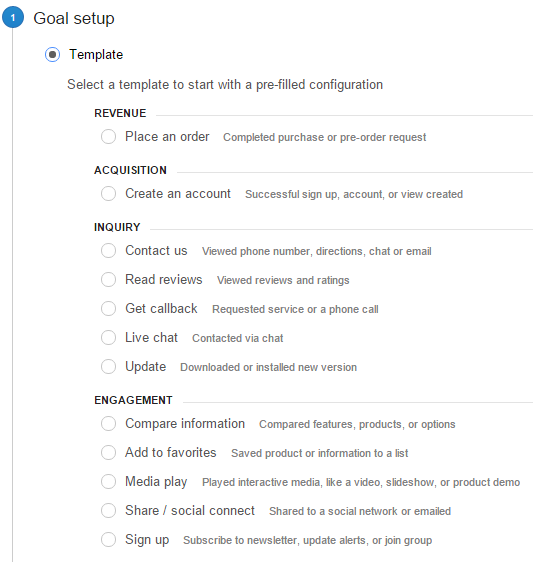
From there, you’ll have the opportunity to set further parameters. For example, if your Goal conversion is the act of “Creating an Account,” you can choose the exact instance when this conversion is counted as complete, such as reaching a “thank you” page:
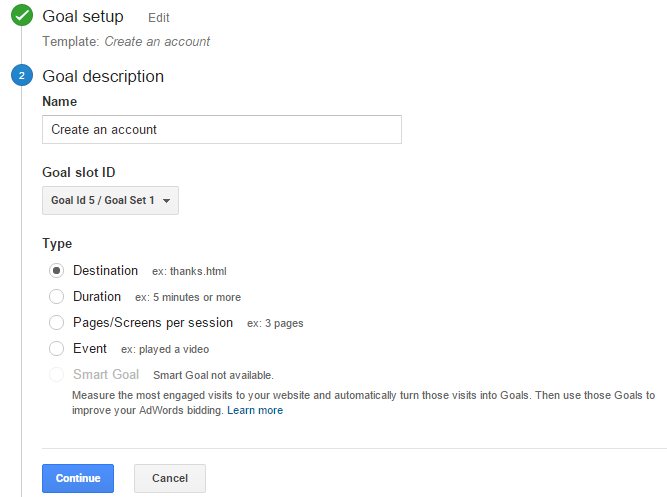
After that, you just need to fill in a few more details (which vary depending on your setup thus far). You can also assign a value (which you’ve already calculated above) or set up a funnel to track only certain types of traffic that convert.
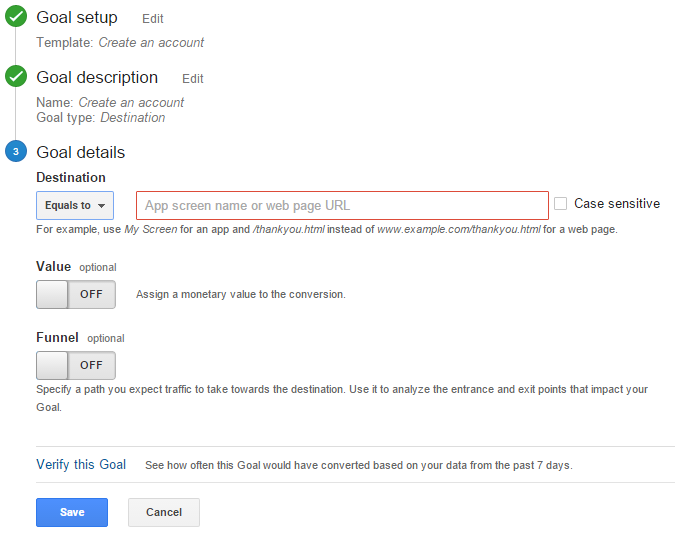
Once created, your Goals (and subsequent reporting) will be the best tools you have to showcase the value your client’s site is bringing in. You’ll be able to view not only how many times the Goal was reached, but demonstrate the actual monetary value of those exchanges.
Now, there’s one flaw with this, and that’s the fact that not all Goal completions will be your doing. To address that, we need to look at the types of strategies you’re using, the types of traffic you’re getting, and the types of traffic that are completing your Goals.
One thing at a time.
Traffic
Since we’re talking about proving your objective value, most of this section will be dedicated to finding traffic you were responsible for generating, and tying those traffic figures to monetary Goal achievements. However, be aware that inbound traffic alone can be considered to have value. For example, every user that arrives at your client’s site and doesn’t convert will at least walk away with a higher awareness of your client’s brand. I’ll talk more about these “hard-to-measure” values in the next section.
Let’s take a look at the major types of traffic that you’ll want to measure. Once logged into Analytics, check out the Acquisition tab, and head to the Overview section.
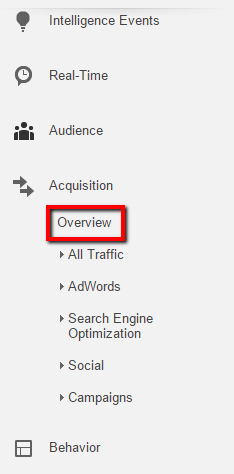
Here, you’ll see a pie chart illustrating the main sources of traffic your client’s site receives (you may see more than these, including advertising traffic, but these four are the primary ones an inbound marketing agency should worry about).
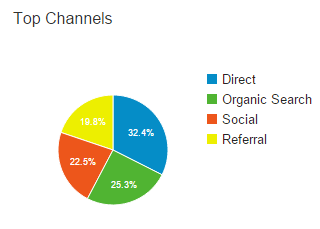
Here:
- Direct traffic refers to any traffic typed into a URL bar or accessed via a bookmark. It’s hard to take credit for any of this traffic, though it’s possible your efforts have raised brand awareness enough to influence it.
- Referral traffic refers to any traffic coming from an outside source. If you’re building links for SEO in a diverse way (as you should), any link-based traffic you generate will be reported here, as will any traffic from any links your content has earned.
- Organic traffic is any traffic that came to your client’s site after finding it in a search engine. It’s the single best indicator you have for the overall success of your SEO campaign. Though some factors beyond your control may influence this figure, it’s almost exclusively a product of your optimization techniques.
- Social media traffic is any traffic that comes from a social media platform. If you’re engaging in social media marketing services, this is another segment you can take full credit for.
In each of these segments of traffic, you can access a “deeper,” more detailed report that will tell you about the type of visitors you receive, where they came from, what they did on the site, and whether or not they converted. For example, the Referral traffic chart will show you the biggest sources of referrals in your backlink profile, and your Social media traffic chart will show you the most popular platforms you use:
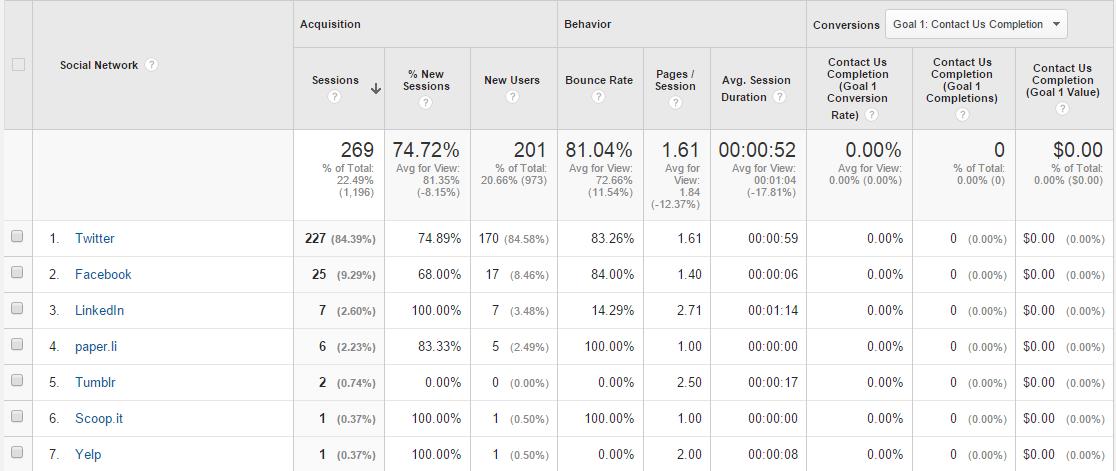
These reports aren’t perfect because you can’t prove the psychology of every user who enters your client’s site, but collectively, they can illustrate the power of your current strategies.
Bringing it All Together
Now, you need to bring all these figures together. Using the individualized traffic reports in combination with your total Goal figures, you can calculate approximately how many conversions your efforts have generated for your client. Combined with your “average conversion” value, you can come up with a specific dollar amount of revenue that your firm is responsible for generating. Compare this to your total monthly cost, and hopefully your newly generated revenue will exceed it. If it does, it means your value is almost conclusively proven. There’s only one point of possible contention here; your marketing firm might be generating your client a profit, but what if another marketing firm can generate a bigger profit? I’ll elaborate on this in my next section.
If your costs exceed your objective value here, don’t worry. This isn’t the only way you can prove your value; you still have two more realms of possible value that you can prove and/or demonstrate for your client.
Comparative Costs: Illustrating the Competitive Advantage
There are two reasons why you’ll want to describe your competitive value, which I alluded to above; first, it allows you to demonstrate that you clients won’t find a higher ROI from someone else, and second, it increases your total value as a company. The goal here is to show that you’re worth more than just your objective ability to increase sales, either because your level of overall service is higher, or because you have some approach, disposition, or ability that your competitors don’t have or can’t match at your price level.
That being said, there are three main ways you can prove your competitive worth.
Know Your Competitors
First, get a feel for what your competition is like. It’s a simple step, but too many marketing firms overlook it. Try to find out what services they offer, how they complete them, how much they cost, and what kind of results they offer.
To start, identify marketing firms similar to yours. You can run a quick Google search to see who else is in your area, or cast a broader net by scoping out national competitors. For example, you could browse marketing-based LinkedIn Groups to find influencers in the industry, or individual consultants who might pose some kind of a threat—in my cursory glance, I found 45,000 such Groups, so don’t feel like you need to peruse all of them:
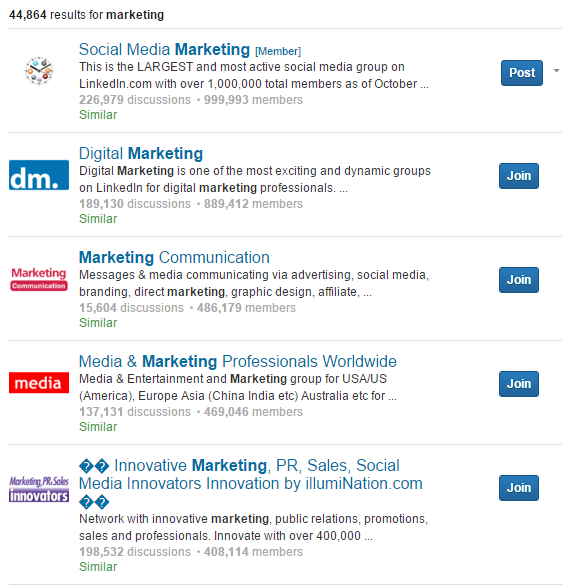
Inc.com also suggests almost 500 of their top 5,000 growing companies are marketing-related.
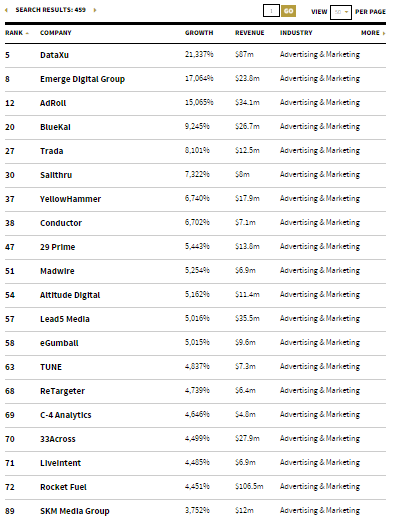
(Image Source: Inc)
Once you find out more about who your competitors are and what they’re doing, you can better position yourself to demonstrate value. For example, if you find out that a close competitor of yours only offers monthly reporting instead of weekly, and has no social media marketing services, you could let your client know what a better deal they’re getting with you.
You could also go a bit more abstract here and demonstrate value with the resources you’re able to provide. For example, you could claim that your experts have more experience than those of your competitors, or that you have access to more sophisticated tracking technology. Just make sure your claims are justified—dishonesty could ruin an otherwise solid reputation.
Make Your Clients Love You
It doesn’t take much to add a personal touch to your service; don’t forget that on the other side of this relationship isn’t a “corporation”—it’s another person, or maybe a few other people, and all of them appreciate the human element of your relationship.
Going the extra mile can give your client those “warm fuzzy” feelings, and help them to see your partnership as an actual partnership, not just a tool to use for their own advancement. This will separate you from the competition, increase the perceived value your agency brings to the table, and make it harder for the client to walk away during brief periods of less-than-stellar results.
Hopefully, you can master this approach intuitively; all you have to do is be friendlier. Opt for in-person meetings and phone calls over emails or text messages. Inject humor and personal conversation into your regular updates. Get to know your clients, and be straightforward and honest with them. Send them a handwritten piece of mail every once in a while, like a thank-you note or a congratulations—they won’t forget it.
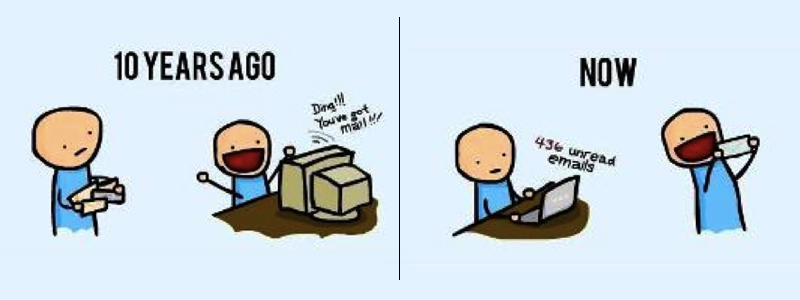
(Image Source: Mark Sanborn)
Try to think about this strategy as little as possible. If you overthink it, your efforts might be misconstrued as insincere or manipulative. Instead, just treat your clients like you’d treat a friend, and truly strive to help them succeed.
Adapt
Digital marketing is a fast-paced industry that responds, sometimes violently, to new technologies and new trends. It’s easy to miss an update here or there with few consequences, but if you do this consistently, it will only take a few years before your entire approach is rendered obsolete. The solution is to adapt, by incorporating new strategies and making new recommendations for your clients whenever possible.
The “newness” of your ideas holds a value, which you can demonstrate to your client (though not in a way as concrete as ROI). If your results are sagging, it could just be because you’re on the cutting edge of the latest marketing trends and you haven’t worked out all the kinks yet. If your pattern of growth has been disrupted, it’s because you’re trying to stay ahead of the competition.
Adaptability is all about taking a short-term risk to avoid a long-term failure, and it’s important that your clients are aware of this. Some marketing firms get by with adhering to now-obsolete practices and never changing them—mark yourself as a differentiator.
Secondary Benefits and Unmeasurable Metrics
Finally, let’s not forget about the secondary benefits all your efforts have for your client’s bottom line. These effects are devilishly hard to pinpoint, and even harder to quantify, but they do exist, and they do provide an extra layer of value to your overall marketing efforts.
Brand Visibility and Reputation
Every time you do something that puts your client’s brand in front of an unfamiliar user, you are generating value for that brand. Imagine some of the following scenarios:
- A social media user shares your socially syndicated article. One of their friends researches your client, visits the site directly, and ends up purchasing from them.
- A frequent visitor of a high-profile publication reads your client’s article (written by you). Intrigued, they follow the link, but take no further action. Two months later, they return via a direct visit and buy something.
- An organic visitor who found your client through search left before buying anything. However, they were impressed, and made a personal referral of your client to three of their close friends.
In all of these instances, your marketing efforts have led to sales for your client due to the brand visibility and reputation increases you’ve sparked. These won’t show up in your Goals report in Google Analytics, and unless you make each user take a survey about what led them to your site, you won’t be able to definitively conclude how many instances like these you’ve prompted.
When a brand appears on publications like these:

It definitely leaves an impression. Be sure to reiterate this value to your clients.
Readership
Your client’s readership pool is a gradually increasing segment of users who either are customers or have a high potential of eventually becoming customers. Some of these make themselves evident by following your client on social media—the behaviors of these are relatively easy to track. Some follow your client via an RSS fed. Some may simply bookmark your client and return to read regularly—but these folks show up as Direct visitors, which normally aren’t credited to a marketing agency.
It’s also hard to quantify the value of things like social shares and social engagements, the former of which is an indication of content success and increased brand reach, and the latter of which is usually associated with a positive increase of brand loyalty. Again, it’s hard to quantify these benefits, but they are there—so don’t neglect to mention them.
Permanence and Compounding Interest
Inbound marketing strategies generally carry some degree of permanence, unlike traditional advertising methods. When you write a blog post for Forbes, it stays up indefinitely—compare that to a billboard that comes down forever after a month of visibility. Accordingly, strategies like content marketing and SEO carry a degree of compounding return; writing 10 blog posts this month gives you 10 blog posts of value. Writing 10 more blog posts next month gives you 20 blog posts of value, and so on. What does this mean?
It means when you’re calculating your current objective value (from the ROI section), you’re only looking at the present value of your efforts. You’re completely ignoring the future value of your efforts, which are significant. For example, if you prove that your $100 blog post yielded 100 new visitors worth $0.50 each, you’d have an on-paper loss of $50. However, this figure doesn’t include the fact that this article may generate 100 more visitors next month, and the month after that.
Your current snapshot does take into consideration the compounding value of previous efforts you’ve taken, but because these strategies often carry exponential rates of return, you still can’t write off the future value of your investments.
Preservation of Momentum
It takes a long time to build momentum in a marketing campaign. It takes months, sometimes even years, to establish a footprint of thought leadership and develop the foundation for a long-term strategy. Part of your value as an agency is staying the course—to follow-up on the strategic foundation you’ve already built. If that course is deviated from, or abandoned, the initial costs of setting it up will also be abandoned, and the client will have to reinvest in a new foundation (unless someone else comes in to build off yours). Accordingly, you can argue that it’s more efficient to continue with you than it is to seek agency elsewhere.
These secondary benefits are just that—secondary—so don’t try to position these as your ultimate statement of value. Instead, use them to complement or enhance your primary arguments.
Key Takeaways
This is a massive guide to try and boil down to a few takeaways, so I’m only going to recap the high level here:
- Know that client retention is the only way to keep your business alive and thriving, and the way to client retention is proving you’re worth more than they’re paying.
- Make sure your agency follows best practices when it comes to engagement, relationship building, and overall disposition—communication is key here.
- Prove your worth using numbers, which can’t be argued with, calculating your costs and your value in terms of newly generated revenue.
- Use competitive research and comparative values to strengthen your worth to your clients.
- Include secondary benefits, even though they’re tough to measure, to complete the picture.
If you can do this, and assuming you’re seeing positive ROI, you should have no trouble demonstrating that you’re worth what your clients are paying you. If you’re struggling to do this, it means you need a change to your strategic approach; your client’s bottom line is your bottom line, so enlist the best services to deliver the best results.
If you run an SEO agency and are looking for link building and private label SEO agency services, please get in touch. We’re the SEO company that specializes in direct and white label link building.
- Earned Links: Content That Earns Backlinks, Drives Traffic & Boosts Authority - April 28, 2025
- Risky SEO Tactics that Kill Your Search Engine Rankings - April 21, 2025
- How to Tell if an SEO Agency Is Trustworthy [in 5 Steps] - April 7, 2025

